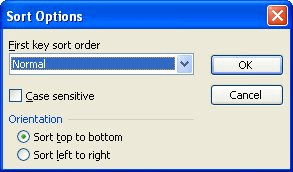Please Note: This article is written for users of the following Microsoft Excel versions: 97, 2000, 2002, and 2003. If you are using a later version (Excel 2007 or later), this tip may not work for you. For a version of this tip written specifically for later versions of Excel, click here: Deleting Blank Columns.
Written by Allen Wyatt (last updated March 16, 2019)
This tip applies to Excel 97, 2000, 2002, and 2003
When importing information from an external source, it is possible that the data will contain blank columns—columns with nothing in them. If you import a lot of data, then deleting these columns can be a bother. There are a couple of ways you can approach how to delete these columns.
The first approach works very well if your data is sorted by column. In other words, the data that you import is in ascending order, or you want it in sorted order. In this case, follow these steps:

Figure 1. The Sort Options dialog box.
When sorting in this manner, all the empty columns end up "pushed" to the right, and your data is in a sorted order.
If you don't want your data sorted, then you can use a nifty macro that will check for blank columns in a selected range and then delete those columns. The following macro will do the trick:
Sub DeleteEmptyColumns()
first = Selection.Column
last = Selection.Columns(Selection.Columns.Count).Column
For i = last To first Step -1
If WorksheetFunction.CountBlank(ActiveSheet.Columns(i)) = 65536 Then
Columns(i).Delete
End If
Next i
End Sub
To use the macro, select the range of columns in which you want blank columns deleted. The macro steps through the columns and if the column is truly blank, it is deleted. You should note that this macro will delete only columns that are truly empty. If cells within a column include a formula that returns a zero value (and you have the display of zeros values turned off) or that returns an empty string, then the column isn't empty—it contains formulas. In this case, the column won't be deleted.
Note:
ExcelTips is your source for cost-effective Microsoft Excel training. This tip (2660) applies to Microsoft Excel 97, 2000, 2002, and 2003. You can find a version of this tip for the ribbon interface of Excel (Excel 2007 and later) here: Deleting Blank Columns.

Excel Smarts for Beginners! Featuring the friendly and trusted For Dummies style, this popular guide shows beginners how to get up and running with Excel while also helping more experienced users get comfortable with the newest features. Check out Excel 2019 For Dummies today!
When working with data in Excel, you might want to figure out which rows of data represent duplicates of other rows. If ...
Discover MoreIf you need to delete a cell, the Delete key won't do it. (That only clears the contents of a cell; it doesn't delete the ...
Discover MoreWhen you want to remove information from a worksheet, you can either clear cells or delete cells. This tip examines the ...
Discover MoreFREE SERVICE: Get tips like this every week in ExcelTips, a free productivity newsletter. Enter your address and click "Subscribe."
There are currently no comments for this tip. (Be the first to leave your comment—just use the simple form above!)
Got a version of Excel that uses the menu interface (Excel 97, Excel 2000, Excel 2002, or Excel 2003)? This site is for you! If you use a later version of Excel, visit our ExcelTips site focusing on the ribbon interface.
FREE SERVICE: Get tips like this every week in ExcelTips, a free productivity newsletter. Enter your address and click "Subscribe."
Copyright © 2025 Sharon Parq Associates, Inc.
Comments